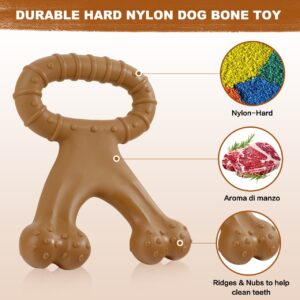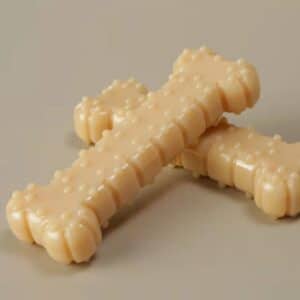p { font-size: 18px; line-height: 1.6; } table { width: 100%; border-collapse: collapse; margin: 20px 0; } table, th, td { border: 1px solid #2E8B57; } caption { font-weight: bold; margin-bottom: 10px; font-size: 20px; } th, td { padding: 12px; text-align: left; } h2, h3 { color: #2E8B57; } ul { margin-left: 20px; } a { color: #2E8B57; }
Giving a dog a bone seems like a natural and rewarding gesture. However, not all bones are safe for dogs, and improper use can lead to serious health issues. This comprehensive guide aims to educate pet owners on the risks associated with giving bones to dogs, how to choose safe alternatives, and what precautions to take to ensure your canine companion stays healthy and happy. We’ll delve into the types of Dog Bone Safety, potential hazards, expert recommendations, and provide valuable insights supported by statistics, case studies, and expert opinions.
Table of Contents
- 1. Understanding the Risks of Giving Bones to Dogs
- 2. Types of Bones: Cooked vs. Raw
- 3. Safe Alternatives to Bones
- 4. How to Choose Safe Chews for Your Dog
- 5. Signs of Bone-Related Health Problems
- 6. What to Do If Your Dog Has a Bone-Related Injury
- 7. Case Studies and Expert Opinions
- 8. Frequently Asked Questions
- 9. Conclusion
1. Understanding the Risks of Giving Bones to Dogs
1.1 Potential Hazards
While dogs have a natural instinct to chew bones, doing so can pose several risks:
- Choking Hazards: Small or broken pieces can lodge in the throat, blocking the airway and causing suffocation.
- Dental Damage: Hard bones can fracture teeth, leading to pain and expensive dental procedures.
- Gastrointestinal Blockages: Swallowed bone fragments can block the digestive tract, requiring emergency surgery.
- Perforations: Sharp bone pieces can puncture the stomach or intestines, leading to internal bleeding and infection.
- Bacterial Infections: Raw bones may carry bacteria like Salmonella or E. coli, posing risks to both pets and humans.
- Constipation: Bone fragments can cause severe constipation due to their indigestible nature.
- Pancreatitis: Fatty bones can trigger inflammation of the pancreas, a painful and potentially life-threatening condition.
1.2 Statistics on Bone-Related Injuries
According to a report by the U.S. Food and Drug Administration (FDA), veterinarians have reported numerous cases of bone-related injuries. A survey of veterinary practices revealed:
- Over 15% of emergency visits are due to gastrointestinal issues, with bone ingestion being a significant cause (JAVMA, 2011).
- Approximately 8% of dogs presented with dental fractures were linked to chewing bones (Veterinary Record, 2010).
- The British Veterinary Association (BVA) reported that 80% of vets had treated dogs for problems caused by chewing bones.
These statistics highlight the prevalence and seriousness of bone-related injuries in dogs.
2. Types of Bones: Cooked vs. Raw
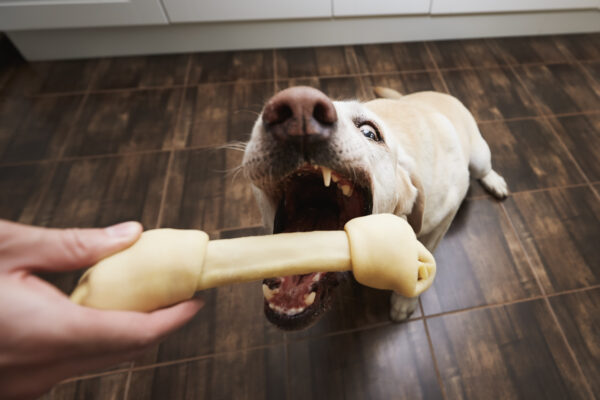
2.1 Cooked Bones
Cooked bones, including those from table scraps, are dangerous for dogs:
- They become brittle and can easily splinter into sharp pieces.
- Common sources include chicken, turkey, pork, and beef bones.
- Even large bones can break and cause harm.
- Cooking processes like baking, boiling, or frying exacerbate the brittleness.
The American Veterinary Medical Association (AVMA) strongly advises against giving cooked bones to dogs. Dr. Carmela Stamper of the FDA’s Center for Veterinary Medicine states, “Eating bones is not safe for your dog, regardless of the size.”
2.2 Raw Bones
Raw bones are less likely to splinter but still pose risks:
- They can carry harmful bacteria like Salmonella and Campylobacter, which can affect both pets and humans.
- Large raw bones may be safer but require supervision to prevent choking and dental injuries.
- They can cause dental fractures due to their hardness. A study in the Journal of Veterinary Dentistry found that 20% of dogs given raw bones suffered from dental fractures (JVD, 2012).
- Raw bones can lead to gastrointestinal issues if not properly handled or if the dog swallows large pieces.
Some veterinarians support the use of raw bones under strict conditions, emphasizing the importance of size appropriateness, hygiene, and supervision.
2.3 Visual Table: Risks of Cooked vs. Raw Bones
| Risk | Cooked Bones | Raw Bones |
|---|---|---|
| Splintering | High Risk | Lower Risk |
| Bacterial Contamination | Lower Risk | High Risk |
| Dental Damage | Possible | Possible |
| Choking Hazard | High Risk | Moderate Risk |
| Gastrointestinal Blockage | High Risk | Moderate Risk |
| Perforations | High Risk | Moderate Risk |
| Pancreatitis | Possible (due to fatty bones) | Possible |
2.4 Expert Opinion
Dr. Michael Richards, a veterinarian with over 30 years of experience, notes, “While raw bones can be safer than cooked, they are not without risks. Pet owners must weigh the potential benefits against the dangers and make informed decisions.”
3. Safe Alternatives to Bones

3.1 Commercial Chew Products
Several safe chew products are designed specifically for dogs:
- Dental Chews: Products like Greenies® and Whimzees® promote dental health by reducing plaque and tartar buildup. Studies have shown that daily use can reduce tartar accumulation by up to 60% (Veterinary Therapeutics, 2008).
- Rubber Toys: Durable toys like KONG® can be filled with treats or peanut butter (ensure it’s xylitol-free) to keep dogs engaged.
- Nylon Bones: Synthetic bones, such as Nylabone®, are tough and long-lasting, satisfying the chewing instinct without the risks of real bones.
- Edible Chews: Made from digestible materials like rice flour or potato starch, these chews break down safely in the digestive system.
3.2 Natural Chew Options
Some natural options can be safer than bones:
- Bully Sticks: Made from dried bull pizzles, they are high in protein and easily digestible. However, they can be high in calories, so moderation is key.
- Himalayan Yak Chews: Hardened cheese chews that are long-lasting and made from natural ingredients. They soften as the dog chews, reducing the risk of dental fractures.
- Fish Skins: Dried fish skins provide omega-3 fatty acids, promoting skin and coat health while satisfying chewing needs.
- Vegetable-Based Chews: Options like sweet potato chews offer a healthy, low-fat alternative.
Note: Always supervise your dog with any chew and choose appropriate sizes to prevent choking hazards.
3.3 Case Study: Safe Chew Transition
Max, a 3-year-old Labrador Retriever, loved chewing on bones but suffered a cracked molar, requiring an extraction costing over $1,000. His owner switched to durable rubber toys and dental chews. Max remained satisfied with his new chews, and subsequent veterinary check-ups showed no further dental issues. This change not only improved Max’s health but also saved his owner from potential future expenses.
3.4 Benefits of Safe Chews
Choosing safe chew alternatives offers several benefits:
- Dental Health: Reduces plaque and tartar, promoting healthy gums and teeth.
- Mental Stimulation: Keeps dogs engaged and reduces boredom-related behaviors.
- Safety: Minimizes risks of choking, dental fractures, and gastrointestinal issues.
- Nutritional Value: Some chews provide additional nutrients beneficial to your dog’s health.
4. How to Choose Safe Chews for Your Dog
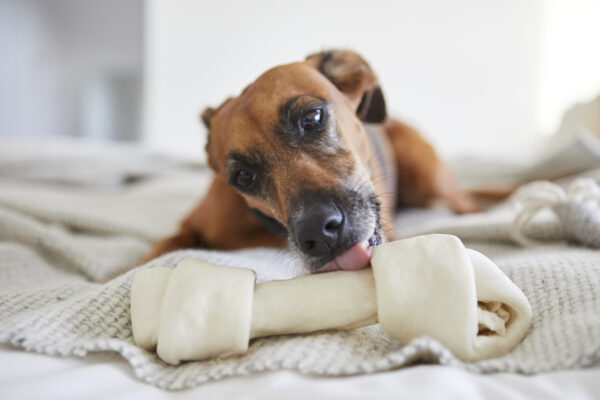
4.1 Consider Your Dog’s Size and Chewing Habits
Not all chews are suitable for every dog:
- Aggressive Chewers: Need durable, tough chews that won’t break easily. Look for products labeled for heavy chewers.
- Soft Chewers: May prefer gentler options like plush toys or softer edible chews.
- Size Appropriateness: Chews should be large enough not to be swallowed whole. A good rule is that the chew should be longer than the length of the dog’s muzzle.
- Age Considerations: Puppies may require softer chews appropriate for teething, while senior dogs may need gentler options due to dental sensitivity.
4.2 Material Safety
Choose chews made from safe materials:
- Non-Toxic: Ensure materials are free from harmful chemicals like BPA, phthalates, and lead.
- Durability: Avoid items that break into sharp pieces or can be easily torn apart.
- Digestibility: Edible chews should be easily digestible to prevent blockages.
- Compliance with Standards: Look for products that meet safety standards set by organizations like the FDA or have veterinary approval.
4.3 Veterinary Recommendations
Consult your veterinarian for personalized advice. They can recommend products based on your dog’s health history and specific needs, such as dental health, allergies, or dietary restrictions. Veterinarians may also have access to prescription dental chews with proven efficacy.
4.4 Visual Table: Comparison of Safe Chew Options
| Product Type | Benefits | Considerations |
|---|---|---|
| Dental Chews | Promote dental health, easily digestible, come in various sizes | Monitor calorie intake; some dogs may consume them quickly |
| Rubber Toys | Durable, can be stuffed with treats, provide mental stimulation | Ensure appropriate size to prevent choking; regular inspection for wear and tear |
| Nylon Bones | Long-lasting, satisfy chewing instinct, available in different flavors | Can be too hard for some dogs, risk of tooth fracture; supervise use |
| Bully Sticks | Natural, digestible, high in protein, appealing taste | Can be high in calories; monitor for choking as they get smaller |
| Himalayan Yak Chews | Long-lasting, natural ingredients, soften over time | Hardness may not suit all dogs; supervise use; can be microwaved when small to puff up and prevent choking |
| Vegetable-Based Chews | Low-fat, suitable for dogs with protein sensitivities | May not last long for aggressive chewers; monitor consumption |
5. Signs of Bone-Related Health Problems
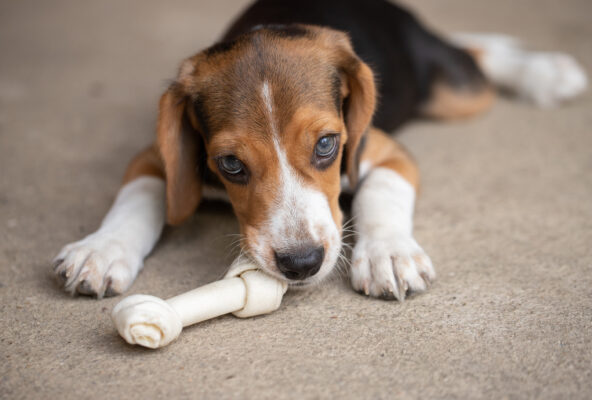
5.1 Symptoms to Watch For
If your dog has consumed a bone, monitor for the following signs:
- Choking or Gagging: Immediate veterinary attention required as it can block the airway.
- Excessive Drooling: May indicate oral injuries or obstructions.
- Pawing at Mouth: Sign of discomfort or lodged fragments.
- Vomiting or Diarrhea: Possible gastrointestinal upset, obstruction, or perforation.
- Lethargy: Indicates discomfort, pain, or internal issues.
- Bloody Stool or Vomit: Sign of internal bleeding or perforation of the digestive tract.
- Abdominal Pain: Sensitivity when touched, bloating, or reluctance to move; may indicate obstruction or perforation.
- Loss of Appetite: Could indicate an obstruction, pain, or infection.
- Constipation: Difficulty passing stool due to bone fragments causing blockage.
- Changes in Behavior: Restlessness, aggression, or signs of distress.
5.2 When to Contact a Veterinarian
If you observe any of these symptoms, contact your veterinarian immediately. Do not wait for symptoms to worsen, as delays can lead to severe complications, including death. Early intervention can prevent serious outcomes and reduce treatment costs.
5.3 Diagnostic Procedures
Your veterinarian may perform:
- Physical Examination: Checking for signs of pain, obstruction, or injury.
- Imaging Tests: X-rays, ultrasounds, or CT scans to locate bone fragments and assess damage.
- Blood Tests: Evaluate for infection, organ function, or signs of internal bleeding.
- Endoscopy: Visual examination and possible retrieval of foreign objects without surgery.
6. What to Do If Your Dog Has a Bone-Related Injury(Dog Bone Safety)
6.1 Immediate Steps
In case of an emergency:
- Stay Calm: Your dog can sense your anxiety, which can exacerbate their stress.
- Do Not Induce Vomiting: Unless instructed by a veterinarian, as it may cause more damage.
- Prevent Further Consumption: Remove any remaining bones or fragments from the area.
- Contact Your Veterinarian: Provide details about the type of bone, time of ingestion, and observed symptoms.
- Transport Safely: If advised to visit the clinic, transport your dog carefully to prevent further injury.
6.2 Veterinary Treatment Options
Treatment will depend on the severity and type of injury:
- Physical Examination: Assessing for visible injuries and pain.
- Imaging Tests: To locate bone fragments and assess internal damage.
- Endoscopy: Non-surgical removal of objects from the esophagus or stomach using a flexible tube with a camera and retrieval tools.
- Surgery: In severe cases, to remove obstructions or repair perforations. This may involve abdominal surgery (laparotomy) or thoracic surgery if the esophagus is involved.
- Medication: Pain relief, antibiotics to prevent or treat infection, and medications to protect the gastrointestinal lining.
- Supportive Care: IV fluids to maintain hydration and electrolyte balance.
- Monitoring: Hospitalization for observation and recovery, especially after surgery.
6.3 Case Study: Emergency Intervention
Bailey, a 5-year-old Beagle, swallowed a cooked chicken bone and began choking. Her owner immediately took her to the emergency vet. An endoscopy was performed to remove the lodged bone from her esophagus. The timely intervention prevented further complications like esophageal perforation. Bailey recovered fully, and her owner implemented strict measures to prevent access to bones in the future.
6.4 Prevention Measures Post-Incident
After a bone-related incident:
- Secure Trash Bins: Use pet-proof containers to prevent access to discarded bones.
- Educate Household Members: Ensure everyone understands the dangers of giving bones to dogs.
- Regular Check-Ups: Schedule follow-up visits to monitor recovery and address any lingering issues.
- Implement Safe Chewing Practices: Provide approved chew toys and supervise chewing activities.
7. Case Studies and Expert Opinions
7.1 Veterinary Warnings
Dr. Karen Becker, a proactive and integrative wellness veterinarian, emphasizes, “The risks associated with giving bones to dogs far outweigh the benefits. Cooked bones are especially dangerous, and raw bones require strict supervision and hygiene practices.”
7.2 Statistical Data
A study in the Journal of Small Animal Practice reported that out of 229 dogs with dietary-related gastrointestinal obstructions, 46% were due to bone ingestion (JSAP, 2015).
7.3 Real-Life Example: The Danger of Cooked Bones
Lola, a 7-year-old Poodle, was given leftover pork rib bones. The bones splintered, causing a perforation in her intestine. Despite emergency surgery costing over $3,000, Lola developed peritonitis and sadly did not survive. This tragic case highlights the severe risks of feeding cooked bones and the emotional and financial toll it can take on pet owners.
7.4 Success Story: Safe Chewing Habits
After attending a pet safety seminar, Emily replaced her dog Rocky’s bone treats with veterinarian-approved dental chews and durable rubber toys. Rocky’s dental health improved, and he remained satisfied with his new chew routine. Regular vet check-ups confirmed the positive impact, and Emily saved money on potential dental procedures. This proactive approach enhanced Rocky’s well-being and strengthened their bond.
7.5 Expert Recommendations
The American Veterinary Dental College (AVDC) advises against giving dogs bones or other objects that are too hard to bend or break. They recommend products that have undergone rigorous testing for safety and efficacy, such as those approved by the Veterinary Oral Health Council (VOHC).
8. Frequently Asked Questions
Q1: Can I give my dog raw bones from the butcher?
A: Raw bones carry risks such as bacterial contamination and potential for tooth fractures. If you choose to give raw bones, consult your veterinarian and follow strict guidelines, including supervision, proper hygiene, and appropriate sizing. It’s essential to weigh the potential benefits against the risks.
Q2: What bones are safe for dogs?
A: No bone is entirely risk-free. Some raw recreational bones (large femur or hip bones) may be safer but still require caution. The AVMA and FDA advise against giving any bones due to the associated risks. Safer alternatives like durable chew toys or vet-approved dental chews are recommended.
Q3: My dog has been chewing bones for years without issues. Should I stop?
A: Even if your dog hasn’t had problems yet, the risks remain. Dental fractures and gastrointestinal issues can develop suddenly. Consider transitioning to safer chew options to prevent potential future health issues. It’s better to be proactive in protecting your dog’s health.
Q4: Are antlers or hooves safe for dogs to chew?
A: Antlers and hooves are very hard and can cause tooth fractures. Many veterinarians advise against them due to the risk of dental damage and gastrointestinal issues. A study in the Journal of Veterinary Dentistry reported increased cases of tooth fractures linked to antler chewing (JVD, 2012).
Q5: How can I keep my dog’s teeth clean without bones?
A: Regular tooth brushing with dog-safe toothpaste, dental chews approved by the VOHC, professional dental cleanings, and dental diets can effectively maintain oral health without the risks associated with bones. Consistency is key in preventing dental disease.
Q6: What should I do if my dog steals a bone from the trash?
A: Monitor your dog closely for any signs of distress or symptoms mentioned earlier. Remove any remaining bones and contact your veterinarian for advice. Prevent future incidents by securing trash bins and educating household members about the dangers.
Q7: Are rawhide chews safe for dogs?
A: Rawhide can pose choking hazards and may contain chemicals from processing. Some dogs may also have digestive sensitivities to rawhide. Opt for rawhide alternatives that are digestible and approved by your veterinarian. Always supervise your dog when giving any chew.
Q8: How can I tell if a chew toy is too hard for my dog?
A: A general rule is the “kneecap test”: if you wouldn’t want to be hit in the kneecap with it, it’s too hard. Alternatively, press your thumbnail into the chew; if it doesn’t leave a mark, it’s likely too hard and may risk fracturing teeth. Choose chews with some give to reduce the risk of dental damage.
9. Conclusion
Ensuring the safety of your dog is a paramount responsibility as a pet owner. While chewing is a natural and beneficial behavior for dogs, providing safe alternatives to bones is essential to prevent serious health risks. Understanding the dangers associated with bones, both cooked and raw, allows you to make informed decisions that protect your canine companion. Always consult your veterinarian when choosing chew products and remain vigilant by supervising your dog during chew time. By taking these precautions, you can promote your dog’s health, happiness, and longevity.
At Flawless Cuties, we’re dedicated to supporting you in providing the best care for your pet. Explore our range of safe chew toys, dental care products, and healthy treats designed to satisfy your dog’s natural chewing instincts without compromising their safety.
I Don’t Want to Hit My Dog, But I Want Them to Obey – What Should I Do? Here’s How to Train Your Dog PositivelyThe Best Homemade Dog Food Recipes: A Comprehensive GuideTop 10 Best Dog Breeds for Apartments: A Comprehensive GuideObedience Puppy Training: A Step-by-Step GuideCan I Pet That Dog? A Comprehensive Guide to Safe and Enjoyable Interactions
Recommended Safe Chew Products
Check out these veterinarian-approved chew options for your dog:
References
- American Veterinary Medical Association (AVMA). (n.d.). Animal Product Warnings. Retrieved from https://www.avma.org/resources-tools/pet-owners/petcare/animal-product-warnings
- U.S. Food and Drug Administration (FDA). (2010). Bones Can Be Dangerous to Your Dog. Retrieved from https://www.fda.gov/consumers/consumer-updates/bones-can-be-dangerous-your-dog
- Journal of the American Veterinary Medical Association (JAVMA). (2011). Complications associated with the use of bones and raw food diets in dogs and cats, 238(12), 1719-1722. doi:10.2460/javma.238.12.1719
- British Veterinary Association (BVA). (n.d.). BVA policy position on raw feeding. Retrieved from https://www.bva.co.uk/take-action/our-policies/raw-feeding/
- DuPont, G. A. (2008). A clinical trial to evaluate the effect of a dental chew on periodontal disease parameters in dogs. Journal of Veterinary Dentistry, 25(4), 229-234. doi:10.1177/089875640802500401
- AVDC. (n.d.). American Veterinary Dental College Position Statements. Retrieved from https://www.avdc.org/
- Streeter, E. M., et al. (2011). Gastrointestinal foreign bodies in dogs and cats: A retrospective study of 208 cases. Journal of Veterinary Emergency and Critical Care, 21(3), 259-265. doi:10.1111/j.1476-4431.2011.00635.x
- Hale, F. A. (2012). Veterinary dental education and the use of antlers and bones as chew toys for dogs. Journal of Veterinary Dentistry, 29(3), 171-173. doi:10.1177/089875641202900308
- Veterinary Oral Health Council (VOHC). (n.d.). Accepted Products for Dogs. Retrieved from http://www.vohc.org/accepted_products.htm
- Joffe, D. J., & Schlesinger, D. P. (2002). Preliminary assessment of the risk of Salmonella infection in dogs fed raw chicken diets. Canadian Veterinary Journal, 43(6), 441-442.
















